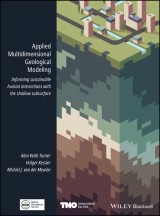Details

Applied Multidimensional Geological Modeling
Informing Sustainable Human Interactions with the Shallow Subsurface1. Aufl.
|
83,99 € |
|
| Verlag: | Wiley-Blackwell |
| Format: | |
| Veröffentl.: | 28.06.2021 |
| ISBN/EAN: | 9781119163114 |
| Sprache: | englisch |
| Anzahl Seiten: | 672 |
DRM-geschütztes eBook, Sie benötigen z.B. Adobe Digital Editions und eine Adobe ID zum Lesen.
Beschreibungen
<p>Over the past decades, geological survey organizations have digitized their data handling and holdings, unlocking vast amounts of data and information for computer processing. They have undertaken 3-D modeling alongside, and in some cases instead of, conventional geological mapping and begun delivering both data and interpretations to increasingly diverse stakeholder communities. <i>Applied Multidimensional Geological Modeling </i>provides a citable central source that documents the current capabilities and contributions of leading geological survey organization and other practitioners in industry and academia that are producing multidimensional geological models.</p> <p>This book focuses on applications related to human interactions with conditions in the shallow subsurface, within 100-200 m of the surface. The 26 chapters, developed by 100 contributors associated with 37 organizations, discuss topics relevant to any geologist, scientist, engineer, urban planner, or decision maker whose practice includes assessment or planning of underground space.</p>
<p><b>Part 1: Introduction and Background</b></p> <p>Chapter 1: Introduction to Modeling Terminology and Concepts<br /><i>Alan Keith Turner, Holger Kessler, and Michiel van der Meulen</i></p> <p>Chapter 2: Geological Survey Data and the Move from 2-D to 4-D<br /><i>Martin Culshaw, Ian Jackson, Denis Peach, Michiel van der Meulen, Richard Berg, and Harvey Thorleifson</i></p> <p>Chapter 3: Legislation, Regulation and Management<br /><i>Brian Marker and Alan Keith Turner</i></p> <p>Chapter 4: The Economic Case for establishing Subsurface Ground Conditions and the Use of Geological Models<br /><i>Jennifer Gates</i></p> <p><b>Part 2: Building and Managing Models</b></p> <p>Chapter 5: Overview and History of 3-D Modeling Approaches<br /><i>Andrew J. Stumpf, Donald A. Keefer, and Alan Keith Turner</i></p> <p>Chapter 6: Effective and Efficient Workflows<br /><i>Donald A. Keefer and Jason F. Thomason</i></p> <p>Chapter 7: Data Sources for building Geological Models<br /><i>Abigail K.Burt , Paul Sirles, and Alan Keith Turner</i></p> <p>Chapter 8: Data Management Considerations<br /><i>Martin L. Nayembil</i></p> <p>Chapter 9: Model Creation Using Stacked Surfaces<br /><i>Jason F. Thomason and Donald A. Keefer</i></p> <p>Chapter 10: Model Creation Based on Digital Borehole Records and Interpreted Geological Cross-sections.<br /><i>Benjamin Wood and Holger Kessler</i></p> <p>Chapter 11: Models Created as 3-D Cellular Voxel Arrays<br /><i>Jan Stafleu, Denise Maljers, Freek S. Busschers, Jeroen Schokker, Jan L. Gunnink, Roula M. Dambrink</i></p> <p>Chapter 12: Integrated Rule-Based Geomodeling – Explicit and Implicit Approaches<br /><i>Martin Ross, Amanda Taylor, Samuel Kelley, Simon Lopez, Cécile Allanic, Gabriel Courrioux, Bernard Bourgine, Philippe Calcagno, Séverine Carit, and Sunseare Gabalda</i></p> <p>Chapter 13: Discretization and Stochastic Modeling<br /><i>Alan Keith Turner</i></p> <p>Chapter 14: Linkage to Process Models<br /><i>Geoff Parkin, Elizabeth Lewis, Frans van Geer, Aris Lourens, Wilbert Berendrecht, James Howard, Denis Peach, and Nicholas Vlachopoulos</i></p> <p>Chapter 15: Uncertainty in Geological Models<br /><i>Marco Bianchi, Alan Keith Turner<sup>2</sup>, Murray Lark, and Gabriel Courrioux</i></p> <p><b>Part 3: Using and Disseminating Models</b></p> <p>Chapter 16: Emerging User Needs in Urban Planning<br /><i>Miguel Pazos Otón, Rubén C. Lois González, Ignace van Campenhout, Jeroen Schokker, Carl Watson, </i><i>Helen Bonsor, Susie Miely, and Michiel J. van der Meulen</i></p> <p>Chapter 17: Providing Model Results to Diverse User Communities<br /><i>Peter Wycisk and Lars Schimpf</i></p> <p><b>Part 4: Case Studies</b></p> <p>Chapter 18: Application Theme 1 – Urban Planning</p> <p>Chapter 19: Application Theme 2 – Groundwater Evaluations</p> <p>Chapter 20: Application Theme 3 – Geothermal Heating and Cooling</p> <p>Chapter 21: Application Theme 4 – Regulatory Support</p> <p>Chapter 22: Application Theme 5 – Geohazard Applications</p> <p>Chapter 23: Application Theme 6 – Urban Infrastructure</p> <p>Chapter 24: Application Theme 7 – Building and Construction</p> <p>Chapter 25: Application Theme 8 – Historical Preservation and Anthropogenic Deposits</p> <p><b>Part 5: Future Possibilities and Challenges</b></p> <p>Chapter 26: Anticipated Technological Advances<br /><i>Matthew Lato, Robin Harrap, and Kelsey </i><i>MacCormack</i></p>
<p><b>THE EDITORS:</b></p><p><b>ALAN KEITH TURNER</b><BR>Emeritus Professor of Geological Engineering, Colorado School of Mines, Golden, Colorado, 80401 USA</p><p><b>HOLGER KESSLER</b><BR>Team Leader, Geological Modeling Systems, British Geological Survey, Environmental Science Centre, Keyworth, Nottingham NG12 5GG UK</p><p><b>MICHIEL J. VAN DER MEULEN</b><BR>Chief Geologist, TNO / Geological Survey of the Netherlands, PO Box 80015, 3508 TA Utrecht, The Netherlands</p>
<p>Over the past decades, geological survey organizations have digitized their data handling and holdings, unlocking vast amounts of data and information for computer processing. They have undertaken 3-D modeling alongside, and in some cases instead of, conventional geological mapping and begun delivering both data and interpretations to increasingly diverse stakeholder communities. <i>Applied Multidimensional Geological Modeling</i> provides a citable central source that documents the current capabilities and contributions of leading geological survey organizations and other practitioners in industry and academia that are producing multidimensional geological models.</p><p>This book focuses on applications related to human interactions with conditions in the shallow subsurface, within 100-200 m of the surface. The 26 chapters, developed by 100 contributors associated with 37 organizations, discuss topics relevant to any geologist, scientist, engineer, urban planner, or decision maker whose practice includes assessment or planning of underground space.</p>

















